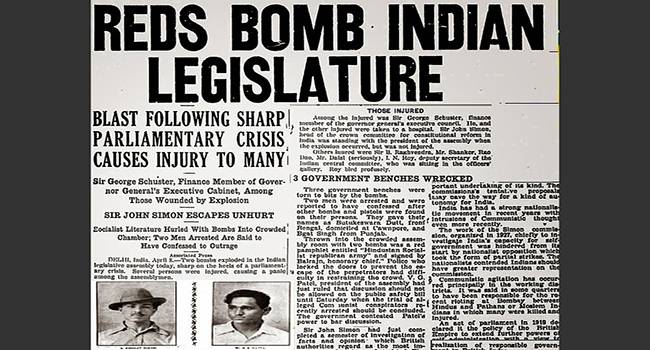[Please note: This page is being compiled. Some of the information in this page may be incomplete. Please bear with us.]
India has seen some of the most powerful people’s movements which led to some of the landmark decisions and brought the entire nation together towards freedom from the colonial rule.
The Revolt of 1857 —the First War of Independence

One hundred years after the Battle of Plassey, anger against the unjust and oppressive British Government took the form of a revolt that shook the very foundations of British rule in India.
While British historians called it the Sepoy Mutiny, Indian historians named it the Revolt of 1857 or the First War of Indian Independence.The causes of the mutiny are hard to pin down, and have been much argued about. Before the Rebellion, there were 50,000 British troops, and 300,000 Sepoy serving in the East India Company military. The immediate event which angered the sepoys was about the ammunition for the new rifles they had to use. The cartridges that were used in the rifles had to be bitten open. The Muslims were angry because they thought that the paper cartridges had pig fat in them. This was because Muslims believe that pigs are unclean. Hindu soldiers were angry because they believed the cartridges had cow fat in them. On January 27, Colonel Richard Birch ordered that no cartridges should have grease on them, and that sepoys could grease them with whatever they wanted. However, this only made the sepoys believe that the stories about the cartridge having pork and beef fat were true. The Revolt of 1857 had been preceded by a series of disturbances in different parts of the country from the late eighteenth century onwards.
Rebellion broke out when a soldier called Mangal Pandey attacked a British sergeant and wounded an adjutant while his regiment was in Barrackpore. General Hearsey ordered another Indian soldier to arrest Mangal Pandey but he refused. Later the British arrested Mangal Pandey and the other Indian soldier. The British killed both by hanging them because what they had done was thought to be treachery. All other soldiers of that regiment lost their places in the army. On May 10th 1857, cavalry troops while doing parade at Meerut broke ranks. They freed the soldiers of the 3rd regiment, and they moved towards Delhi. Soon many Indians of north India joined these soldiers. They entered the Delhi Fort where Bahadur Shah II, the Mughal Emperor, lived, and asked him to become leader of the rebellion. He agreed unwillingly. Very soon the revolt spread throughout north India. Important Indian leaders of royal families joined the rebellion, and started fighting the British at several places. They included: Ahmed Ullah, an advisor of the ex-King of Oudh; Nana Saheb, his nephew Rao Saheb, and his retainers, Tantia Tope and Azimullah Khan; the Rani of Jhansi; Kunwar Singh; the Rajput chief of Jagadishpur in Bihar; and Firuz Saha, a relative of the Mughal Emperor, Bahadur Shah.
At the beginning the British were slow to respond. Then they took very quick action with heavy forces. They brought their regiments from the Crimean War to India. They also redirected many regiments that were going to China to India. The British forces reached Delhi, and they surrounded the city from 1st July 1857 until 31st August 1857. Eventually street-to-street fights broke out between the British troops and the Indians. Ultimately, they took control of Delhi. The massacre at Kanpur (July 1857) and the siege of Lucknow (June to November 1857) were also very important. (Courtesy: Wikipedia)
Read more on this at: https://simple.wikipedia.org/wiki/Indian_Rebellion_of_1857
Films Related to the Revolt of 1857
Further Readings:
Biswamoy Pati (Ed.). The Great Rebellion of 1857 in India: Exploring Transgressions, Contests and …
Routledge, New York, 2010
Rudrangshu Mukherjee. Awadh in Revolt, 1857-1858: A Study of Popular Resistance
By Rudrangshu Mukherjee. Permanent Black, Delhi, New Edition 2001, First Edition 1984.
April 8, 2022 - Smoke Bombs at the Delhi Central Legislative Assembly

On April 8 in 1929, Bhagat Singh and Batukeshwar Dutt threw political handouts and smoke bombs at the Delhi Central Legislative Assembly.
On that day, two young Indian revolutionaries turned the deaf, aristocrat British ears towards a youth upheaval that changed the course of India’s freedom movement. In 1929, in order to court arrest, Shaheed Bhagat Singh and Batukeshwar Dutt threw political handouts and smoke bombs at the Delhi Central Legislative Assembly.
While events like the Sepoy mutiny played an important role in Indian history, they were led by a small group of people in the British army. Here is a list of 9 most powerful and talked about movements in Indian history which were led by citizens –
1. Swadeshi Movement – 1905
The movement which started during India’s struggle for freedom focused on removing the British Empire from power by becoming Swadesh i.e self sufficient. A lot of Indians came forward in support of the movement and boycotted foreign goods. They burnt all the imported clothes they had, boycotted British products and revived the production of domestic commodities. It gave people the power to speak against the authority and the courage to express their views.
2. Satyagraha

SOURCE: YANN/WIKIPEDIA
Probably one of the most noted movements in Indian history, Satyagraha brought thousands of people together in a peaceful way. The non-violence movement started by Mahatma Gandhi to send the British back to their country and leave India free of foreign rule did eventually taste success.

